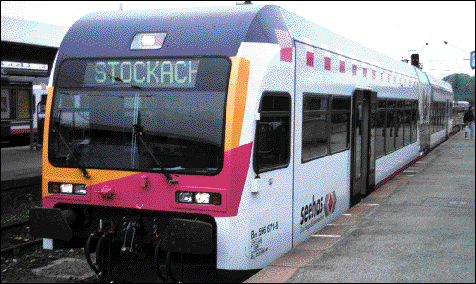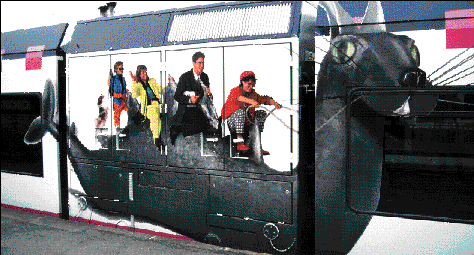Article from Moving People, Nov., 1996. Index.
The historic city of Konstanz, astride the border of Switzerland and Germany on the mountain lake of the same name, has neighborhoods in each nation and a pattern of regional commuting that cuts across borders. In the past three years, it has finally gained a system of local train service that fits local travel patterns.
The Mittel-Thurgau-Bahn (MThB), the heads-up Swiss private railway that traditionally ran a 30-mile hill-and-dale line due south from Konstanz to a junction with the Swiss Federal Railway at the town of Wil, had been looking hungrily for new markets. Always enterprising, but realistically quite limited by the lack of major tourist destinations or traffic potential in its neighborhood, it looked across the border into Germany.
The opportunity came because of the German move to regionalization of local rail services, ordered under legislation that unified the east and west German railways as Deutsche Bahn. Regional authorities newly saddled with local service were no longer forced to contract with DB, but could choose an alternate local company to run the service. DB track access costs are lower than its rivals, but not enough to claim every contract.
Competition by foreign rail companies was not really what the German legislation anticipated but that's what happened. The Swiss MThB bid and won a procurement by the German state of Baden to provide an S-Bahn-style half-hourly service on a 28-mile electrified route serving Konstanz, Singen, and Engen starting in February 1994. Capital costs were less than $2 million per mile.
This service now operates under the name, "Bodensee-Hegau-Bahn" but the marketing identity of the MThB dominates the service, at least partly because of the zany graphics and paint scheme.
The tiny railway's ability to provide a cost-effective service on the German Rail (DB) tracks was partially due to existence of its adjacent Konstanz-Wil train service.
Apparently, the idea of Swiss railroads invading German territory is totally feasible. Within four months of the start of service, MThB had to add cars to handle heavy traffic on its half-hourly shuttle between Konstanz and Engen using electric multiple units. What started out as a six car service now requires sixteen.
Many operators of local transit would rest on their laurels after such a success, but MThB has a different idea: further territorial expansion, on a pair of DB branch lines that had no passenger service. Since MThB had to share part of its windfall from unexpected revenues with the state, there was funding available on each side to expand the service.

MThB spent its windfall on new capital, three very interesting new diesel-electric railcars from Adtranz, the new ABB-Daimler Benz rail equipment consortium. The new cars also had the participation of Swiss railcar builder Stadler, Alusuisse, and motive power provider MTU. The design places a 540kW diesel engine in the articulated center section of the car, right on top of the only powered truck, which has a traction motor on each axle and a passenger. Perhaps the future will also see a pantograph on these cars.
Service with this unique equipment began in September linking the shuttle at Radolfzell to Stockach. Interiors are extremely similar to those of the RegioSprinter, and include "flexi-space" with vertical bike racks. At Radolfzell platforms, passengers have to step down into the car. At other stops on the branch line, low platforms prevail.

The weight of the diesel provides excellent traction, and the car seem to ride quite smoothly. The car carries the unlikely name of Seehas (Lake Rabbit),and is decorated with a surreal illustration of a bunny-headed sea monster.
Additional cars to arrive soon will be used on a second branch from Singen to Etzwilen, back into Swiss territory. This track was under Swiss Federal Railway (SBB) ownership but passenger service had been discontinued.
The latest development for the Mittel-Thurgau-Bahn also involves SBB. To obtain the network benefit of the new cross-border connection, MThB successfully lobbied the Swiss parliament to give it operating rights on the SBB line between Schaffhausen and Romanshorn. With this addition, MThB will have grown fourfold into a 130 mile network.
Although this arrangement is to be on a trial basis for a 10-year period, SBB's press release from February 1996 makes it clear that the national railroad is very displeased: Die SBB bedauern diesen Entscheid.(regrets this decision)
SBB allows as how a number of unsettled issues remain regarding the exact terms of restructuring, freight service provision (which SBB wishes to continue), traffic and energy issues, as well as stipulation of financial arrangements. Given the talents of the MThB, maybe the best approach for the Swiss Federal Railway is cooperation.